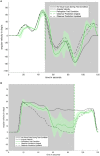Humans gradually integrate sudden gain or loss of visual information into spatial orientation perception
- PMID: 38260024
- PMCID: PMC10800753
- DOI: 10.3389/fnins.2023.1274949
Humans gradually integrate sudden gain or loss of visual information into spatial orientation perception
Abstract
Introduction: Vestibular and visual information is used in determining spatial orientation. Existing computational models of orientation perception focus on the integration of visual and vestibular orientation information when both are available. It is well-known, and computational models capture, differences in spatial orientation perception with visual information or without (i.e., in the dark). For example, during earth vertical yaw rotation at constant angular velocity without visual information, humans perceive their rate of rotation to decay. However, during the same sustained rotation with visual information, humans can continue to more accurately perceive self-rotation. Prior to this study, there was no existing literature on human motion perception where visual information suddenly become available or unavailable during self-motion.
Methods: Via a well verified psychophysical task, we obtained perceptual reports of self-rotation during various profiles of Earth-vertical yaw rotation. The task involved transitions in the availability of visual information (and control conditions with visual information available throughout the motion or unavailable throughout).
Results: We found that when visual orientation information suddenly became available, subjects gradually integrated the new visual information over ~10 seconds. In the opposite scenario (visual information suddenly removed), past visual information continued to impact subject perception of self-rotation for ~30 seconds. We present a novel computational model of orientation perception that is consistent with the experimental results presented in this study.
Discussion: The gradual integration of sudden loss or gain of visual information is achieved via low pass filtering in the visual angular velocity sensory conflict pathway. In conclusion, humans gradually integrate sudden gain or loss of visual information into their existing perception of self-motion.
Keywords: disorientation; orientation perception; pilot; spatial orientation; vestibular; vestibular orientation; visual orientation.
Copyright © 2024 Voros, Kravets, Smith and Clark.
Conflict of interest statement
The authors declare that the research was conducted in the absence of any commercial or financial relationships that could be construed as a potential conflict of interest.
Figures








Similar articles
-
Frequency-dependent integration of auditory and vestibular cues for self-motion perception.J Neurophysiol. 2020 Mar 1;123(3):936-944. doi: 10.1152/jn.00307.2019. Epub 2020 Jan 15. J Neurophysiol. 2020. PMID: 31940239 Free PMC article.
-
Perception of motion and position relative to the earth. An overview.Ann N Y Acad Sci. 1992 May 22;656:315-28. doi: 10.1111/j.1749-6632.1992.tb25218.x. Ann N Y Acad Sci. 1992. PMID: 1599152 Review.
-
Visual contributions to human self-motion perception during horizontal body rotation.Arch Ital Biol. 2000 Apr;138(2):139-66. Arch Ital Biol. 2000. PMID: 10782255
-
Self-motion perception during conflicting visual-vestibular acceleration.J Vestib Res. 2008;18(5-6):267-72. J Vestib Res. 2008. PMID: 19542600
-
Mathematical models for dynamic, multisensory spatial orientation perception.Prog Brain Res. 2019;248:65-90. doi: 10.1016/bs.pbr.2019.04.014. Epub 2019 May 24. Prog Brain Res. 2019. PMID: 31239146 Review.
References
-
- Ayiei A., Murray J., Wild G. (2020). Visual flight into instrument meteorological condition: a post accident analysis. Safety 6:19. doi: 10.3390/safety6020019 - DOI
-
- Bellenkes A., Bason R., Yacavone D. W. (1992). Spatial disorientation in naval aviation mishaps: a review of class a incidents from 1980 through 1989. Aviat. Space Environ. Med. 63, 128–131. PMID: - PubMed
-
- Benson A. J. (1978). “Spatial disorientation—general aspects” in Aviation medicine. eds. Ernsting J., Nicholson A. N., Rainford D. J. (Oxford: Butterworth; )
LinkOut - more resources
Full Text Sources
Miscellaneous

